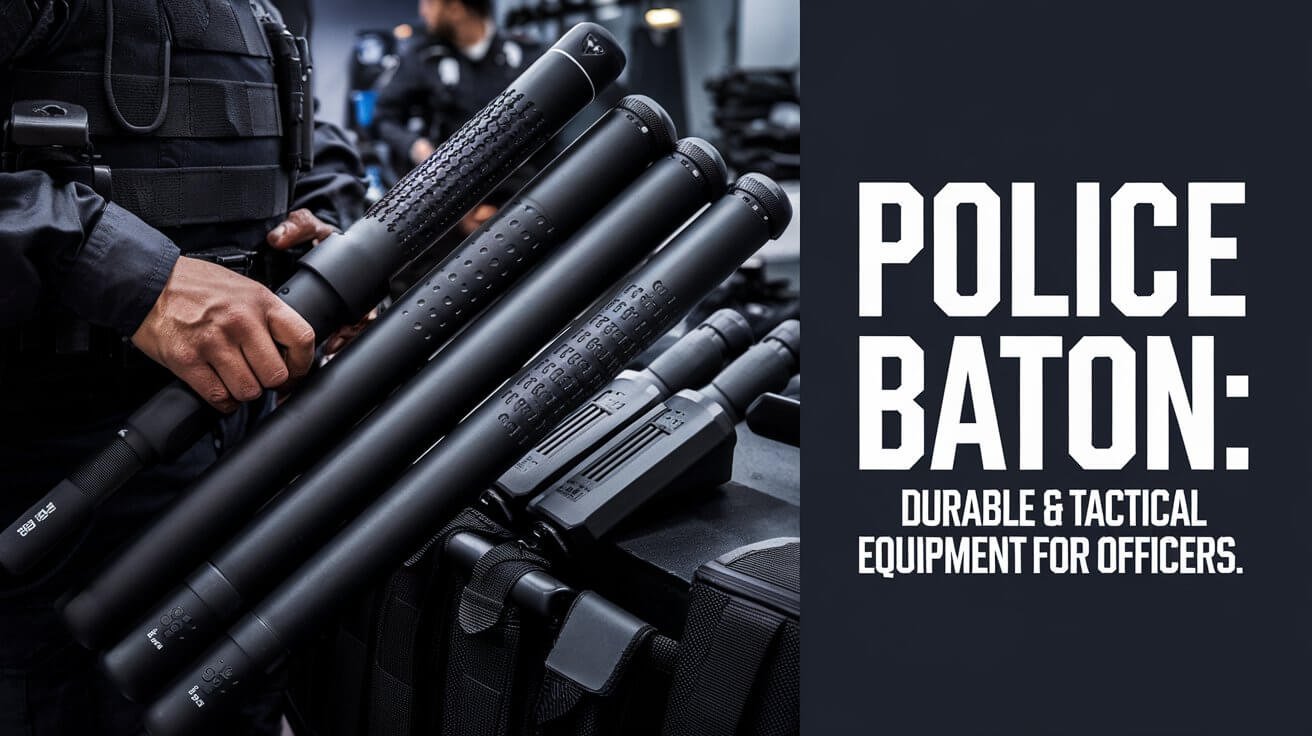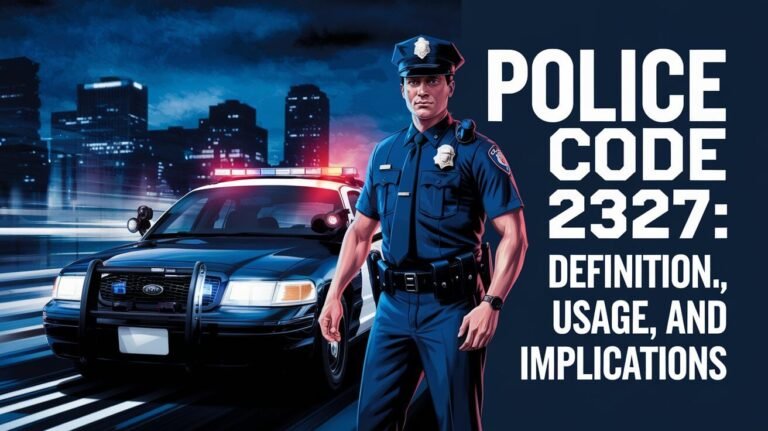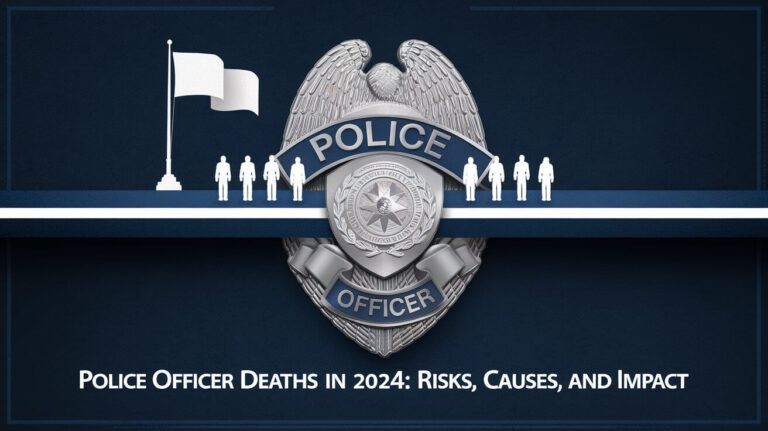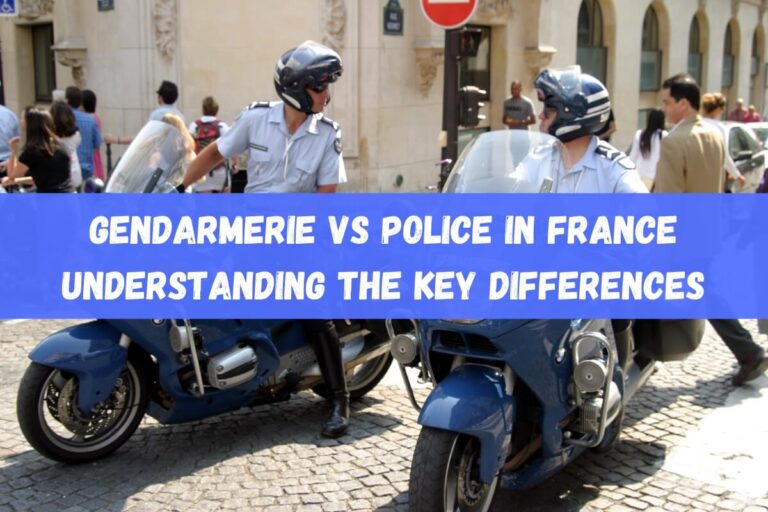Police Baton: Durable & Tactical Equipment for Officers

Police batons are key in keeping communities safe. They come in many types, from traditional nightsticks to modern expandable ones. These tools help officers protect themselves and others safely.
Batons are built to last and serve many purposes. They come in different styles, like expandable and stun batons. ASP, Inc. has made these tools for over 40 years. They offer a safer option than guns or knives for officers.
History and Evolution of Police Batons
The first police batons were made of wood in the 19th century. Over time, their design and materials have changed a lot. This change was due to new technology in law enforcement.
Wooden nightsticks were common before. Now, most police use expandable batons. These are made from steel, aluminum, and plastic. They are stronger and more versatile than old nightsticks.
Expandable batons have made a big difference. They help officers defend themselves and control crowds better. This is a big step in the history of police batons.
Key Developments in Police Baton Design
- Introduction of side-handle batons, such as the Monadnock PR-24, in the 1970s
- Development of expandable batons, such as those manufactured by ASP Inc., founded in 1976
- Advances in materials and mechanisms, leading to improved performance and safety
The design of police batons has improved a lot. This is because of new technology. As technology keeps getting better, we can expect even more improvements in police batons.
Materials and Construction Analysis
Police baton materials are key to their durability and effectiveness. The Galls website says batons are made from steel, aluminum, and plastic. How a baton is built affects its ability to last through law enforcement work.
Type of material used changes the baton’s weight, balance, and how well it works. Steel batons are heavy and last long but cost more. Aluminum batons are lighter and cheaper but not as durable. Plastic batons are the cheapest but not best for stressful situations.
The following table highlights the key characteristics of different police baton materials:
| Material | Weight | Durability | Cost |
|---|---|---|---|
| Steel | Heavier | High | Higher |
| Aluminum | Lighter | Medium | Lower |
| Plastic | Lightest | Low | Lowest |
Materials and construction of police batons are vital. By picking the right materials and building methods, law enforcement can give their officers the best tools. These tools help officers do their jobs safely and well.
Types of Police Batons on the Market
Police batons are key tools for law enforcement. There are fixed-length, telescopic, and side-handle batons. Each has its own benefits, and officers must pick the right one for their job.
Fixed-length batons are classic and easy to use. Telescopic batons, on the other hand, are more versatile and convenient. ASP, Inc. offers various telescopic batons, like the Friction Baton and the Talon Infinity Baton. These come in different lengths and weights to fit different needs.
Comparison of Telescopic Batons
| Baton Model | Retracted Length | Weight (Steel) | Weight (Airweight) | Customer Rating |
|---|---|---|---|---|
| Friction Baton (16″) | 6.20 inches | 13.3 ounces | 7.3 ounces | ★★★★★ (50 reviews) |
| Friction Baton (21″) | 7.70 inches | 16.3 ounces | 8.9 ounces | ★★★★★ (82 reviews) |
| Talon Infinity Baton (40cm) | 7.25 inches | 15.7 ounces | 9.4 ounces | ★★★★★ (33 reviews) |
Officers should think about durability, versatility, and effectiveness when picking a baton. The right baton, whether fixed-length or telescopic, ensures they have the best tool for the job.
Essential Safety Protocols
Police baton safety is key, and safety protocols help a lot. Training is vital for officers to use batons well. The Bureau says ongoing training is important, even though it’s not required by law.
Safety protocols are very important. They help avoid accidents and let officers do their jobs safely. Some main parts of these protocols include:
- Proper training and handling of police batons
- Understanding the risks and hazards of police batons
- Reducing the chance of injury to officers and civilians
- Ensuring officers can use strikes safely without causing lasting harm
Good safety protocols also mean being accountable and using batons responsibly. This means reporting any fights involving security guards. It also means employers must act to stop such incidents. The Bureau can suspend guards who are a danger to public safety, showing how important it is to follow safety rules.
| Aspect of Safety Protocol | Importance |
|---|---|
| Proper Training | Equips officers with necessary skills to handle situations confidently and responsibly |
| Accountability | Prevents abuse and ensures that officers are held responsible for their actions |
| Minimizing Risk | Prevents accidents and ensures that officers can execute their duties without causing harm |
Focusing on police baton safety and following safety rules, law enforcement can build a culture of responsibility. This makes police baton use more effective in keeping everyone safe.
Legal Requirements and Regulations
It’s key to know the laws about police batons for law enforcement and everyone else. Laws about police batons differ in the U.S., with federal rules guiding state laws. It’s vital to follow these rules to avoid legal trouble.
Federal rules stress using the least amount of force and proper training for baton use. State laws, though, vary on who can carry and use batons. For example, some places like California ban batons, while others like Alabama allow them openly or hidden.
Federal Guidelines
Federal rules are important for police baton laws. They help set standards for states, ensuring baton use is fair nationwide. These rules focus on training, using force wisely, and keeping everyone safe.
State-Specific Laws
State laws on police batons are varied and complex. Some states have strict rules, while others are more relaxed. For instance, Florida doesn’t let you carry a baton without a permit, but Massachusetts is okay with it if it’s not hidden.
| State | Law |
|---|---|
| California | Prohibits possession and carrying of batons |
| Alabama | Allows open and concealed carry without restrictions |
| Florida | Prohibits carrying a baton without a valid permit |
| Massachusetts | Allows possession of batons if not concealed or covered |
Remember, police baton laws can change, so it’s important to keep up with updates. Knowing both federal and state laws helps ensure everyone follows the rules about police batons.
Professional Training Requirements
For law enforcement officers, staying updated is key. Police baton training is a big part of this. The ASP, Inc. website says training is vital, including baton use. It makes officers safer and more effective.
The Baton Training course teaches officers how to use batons well. It lasts 8 hours. You need to be 18 or older and have a California Guard Card or be applying for one.
Training brings many benefits. It makes officers and suspects safer. It also makes officers more confident and effective. Plus, it helps them understand the law better.
After finishing the course, officers get two new certificates. These are important for security and protection jobs. The PPBT® “Personal Protection Baton Tactics” program has an 8-hour Instructor course. Officers can then teach a 4-hour Basic Course after that.
Maintenance and Care Instructions
Keeping your police baton in top shape is key. Regular cleaning with mild soapy water is a must. This helps keep the baton strong and ready for use.
Experts say to check your baton every week if you use it daily. Look for damage and test its function. Also, do a full check-up once a month. This ensures your baton works well and lasts longer.
Here are some tips for baton care:
- Keep the baton in a cool, dry spot to avoid damage.
- Have a backup baton for when yours is being checked or fixed.
- Regularly check and test your baton as part of its upkeep.
Sticking to these care tips, your baton will last longer. Regular checks keep it working right. This is vital for police work.
| Maintenance Task | Frequency |
|---|---|
| Weekly routine check | Every week |
| Monthly full maintenance check | Every month |
| Functionality tests | At least once a month |
Make baton care a priority. Follow these steps to keep your baton in top condition. This is essential for effective law enforcement.
Tactical Applications and Techniques
Police baton tactics and techniques are key in law enforcement training. They focus on using batons safely and effectively in different situations. The ASP, Inc. website says batons are a safe and effective tool for protection.
Training includes learning about crowd control and self-defense with batons. Officers learn to use batons safely and with minimal force. They also learn to help injured people after a force incident.
Some important parts of police baton tactics and techniques are:
- Identifying the right use of force and de-escalation tactics
- Understanding when to use police batons
- Mastering disengagement techniques and strikes
- Knowing safety zones and vulnerable body areas
Teaching police baton tactics and techniques, officers get the skills to handle various situations safely. This training is vital for reducing injuries to officers and the public. It also helps in making law enforcement more accountable and transparent.
Size and Weight Specifications
Size and weight are key when it comes to police batons. Different batons have different sizes and weights. For example, the APEX RazorBaton is 1.5 inches wide and comes in 32, 33, or 34 inches long. It’s also designed to be lighter and faster than other batons.
The weight and size of a police baton matter a lot. A baton that’s too heavy or too light can be hard to use. It also needs to be long enough to reach but not so long it’s hard to handle. Most police batons are between 26 and 36 inches long.
Standard Measurements
Police batons come in various sizes and weights. You might find them in 16, 21, or 26 inches long. Their weight can range from 0.86 to 1.23 lbs. The right size and weight are key for effective use in stressful situations.
Weight Distribution
The way a baton is weighted is also important. A well-balanced baton is easier to use and more effective. The APEX RazorBaton, for example, is designed for balanced use. The right size and weight are essential for effective use in high-pressure situations.
Durability and Performance Factors
Police batons need to be tough and work well in many situations. Their strength is key to keeping officers safe. Studies show that modern steel batons are almost as effective as wooden ones, showing the importance of the right materials.
The weight and length of a baton matter a lot. It should be heavy enough to be effective but not so heavy it’s hard to use. For example, the ASP Friction Airweight baton is 11.2 ounces and 26 inches long. It’s a favorite among police. But the Cold Steel 26 baton, at 19.4 ounces, might be better in some cases but harder to manage.
Some notable batons and their characteristics are:
- ASP Agent Infinity baton: 16 inches expanded length, weighs 13.1 ounces
- Smith & Wesson HT baton: 26 inches expanded length, weighs 19.8 ounces
- NEX Steel Push Button baton: 26 inches expanded length, weighs 25.1 ounces
The right baton depends on what the police need and what the officer likes. Thinking about durability, performance, and weight helps officers pick the best gear for their job.
| Baton Model | Expanded Length | Weight | Price |
|---|---|---|---|
| ASP Friction Airweight | 26 inches | 11.2 ounces | $142 |
| Cold Steel 26 | 26 inches | 19.4 ounces | $26 |
| ASP Agent Infinity | 16 inches | 13.1 ounces | $219 |
Expert Tips for Selection
Choosing the right police baton is key, as experts say. The Galls website notes that durability, effectiveness, and budget are important. A recent national conference showed that many officers haven’t used a baton in a year.
This shows how budget matters in picking a baton. Prices range from $27 for the Cold Steel Brooklyn Bats to $198 for the ASP Agent Infinity Concealable Baton. The ASP Talon Infinity Steel Baton, priced at $179.99, is a top choice. It has a special lock that needs manual operation to open.
Professional Recommendations
Experts say to think about your job and body type when picking a baton length. Uniformed officers often choose sizes between 21-26 inches. The ASP baton ranges from 16-31 inches.
The baton’s weight is also key. The ASP Talon Infinity Steel Baton weighs 18.3 ounces for steel and 11.2 ounces for Airweight.
Budget Considerations
Budget is a big deal when choosing a baton. Here are some options:
| Baton Model | Price | Length | Weight |
|---|---|---|---|
| ASP Talon Infinity Steel Baton | $179.99 | 16-31 inches | 18.3 oz (steel), 11.2 oz (Airweight) |
| ASP Friction Loc Baton | $141.99 | 16-31 inches | 16.3 oz (steel), 8.9 oz (Airweight) |
| Streetwise Expandable Baton | $33 | 8-21 inches | 1.3 lbs |
looking at these factors and options, officers can make a smart choice. They should consider expert advice, professional suggestions, and their budget.
Endnote
Police batons are key for law enforcement, keeping everyone safe. They’ve changed a lot, from old wooden nightsticks to new expandable batons. These self-defense tools now use the latest technological advancements.
If you’re a cop or just curious, police batons are vital for safety. They help officers handle tough situations without using deadly force. This makes the community safer.
When dealing with police batons, know the legal requirements in your area. Always put safety first for everyone. By knowing how these self-defense tools work, we can make our community safer for everyone.






